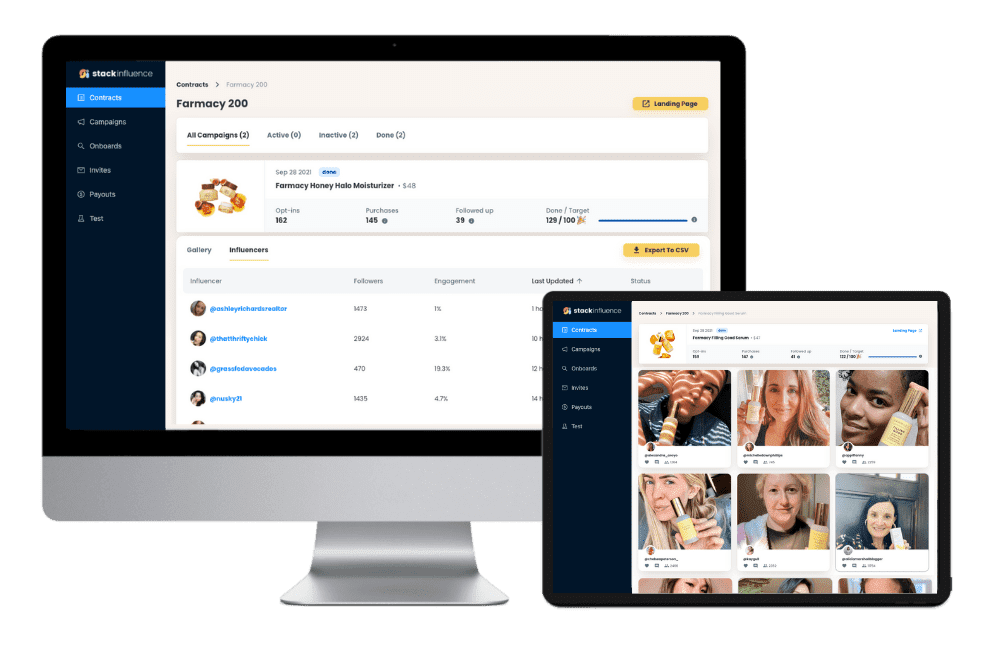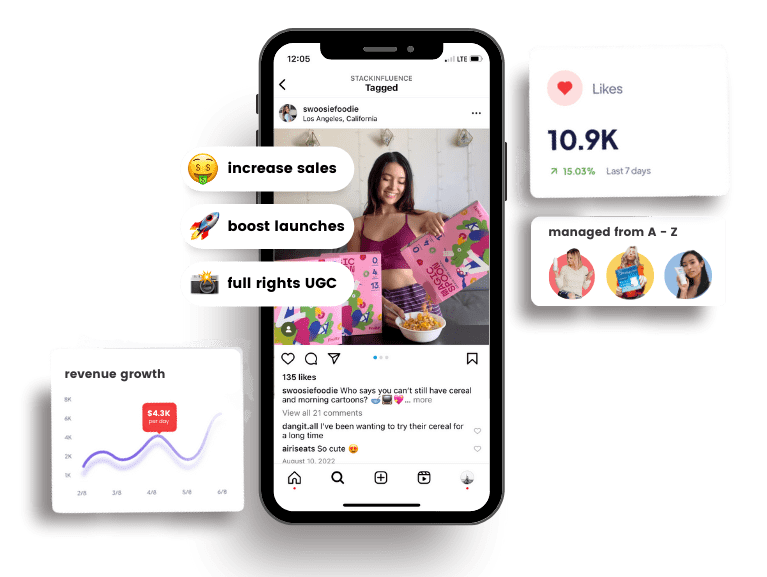Brands Looking for Influencers in 2025
15th
August, 2025
Influencer Marketing
Amazon Marketplace
Artificial Intelligence
TikTok Tips
The influencer marketing boom shows no signs of slowing – and it’s not just mega-celebrities cashing in. Brands of all sizes, from trendy startups to retail giants, are actively looking for influencers (especially micro-influencers) to promote their products. In fact, the global influencer marketing industry is projected to reach $32.5 billion by 2025 (up from $24 billion in 2024). An astounding 86% of U.S. marketers plan to partner with influencers in 2025, highlighting how mainstream this strategy has become for brand growth.
Why the rush to collaborate with micro-influencers, content creators, Amazon sellers, and UGC producers? Simply put, micro-influencers (those with tens of thousands of followers or less) offer authenticity and engagement that big names often can’t match. Surveys show 82% of consumers are highly likely to follow a micro-influencer’s recommendation, and nearly 90% say authenticity is important when deciding which brands to support. User-generated content (UGC) from these everyday creators feels more genuine than polished ads, building trust with audiences. It helps explain why micro-influencers boast engagement rates as high as 5–20%, while macro influencers (huge followings) see only about 1–3% engagement. Higher engagement means a loyal community more likely to act on recommendations. This engagement, coupled with the cost-effectiveness of working with smaller creators, leads to impressive returns. One study found micro/nano-influencer campaigns can deliver ~20:1 ROI (each $1 yielding $20 in revenue) versus roughly 6:1 for macro-influencers. In other words, brands get more bang for their buck collaborating with many niche creators than blowing a budget on one celebrity.
Average engagement rates and ROI for micro- vs. macro-influencer campaigns. Micro-influencers tend to have far higher engagement (~10% vs ~2%) and more than triple the ROI of campaigns with big influencers.
Given these advantages, it’s no wonder e-commerce companies, Amazon sellers, and even household-name brands are ramping up micro-influencer collaborations in 2025. Below, we spotlight 10 notable brands looking for influencers – spanning fashion, beauty, lifestyle, and tech – and how they’re partnering with creators for mutual success. Whether you’re a content creator seeking collabs or a brand curious about influencer strategies, these examples show the power of the right partnership.
1. La Croix
Category
Beverage (Sparkling Water)
The sparkling water brand La Croix is proof that you don’t need a million followers to get a brand deal. La Croix actively works with micro-influencers – even those under 1,000 followers – to showcase their colorful cans on social media. Instead of heavy traditional advertising, La Croix teamed up with niche wellness communities (like the Whole30 program) and everyday fans, encouraging them to post using hashtags like #LaCroixLove and #LiveLaCroix. The brand even sends free product vouchers to micro-influencers to spur content creation. By featuring user posts in a “Live LaCroix” gallery on its site, La Croix turns UGC into authentic marketing. Takeaway: Branded hashtags and free samples have helped La Croix build a grassroots army of brand advocates online.

Unlock the Power of Micro Influencers and Elevate your Brand Today!

2. Daniel Wellington
Category
Fashion Accessories (Watches)
Iconic watchmaker Daniel Wellington practically wrote the playbook on micro-influencer marketing. The company grew explosively by offering free watches or perks to influencers in exchange for social posts featuring its minimalist timepieces. It runs daily content contests (e.g. the #DWPickoftheDay challenge) to encourage creative posts, with winners getting featured on the official account. This strategy turned thousands of fashion-conscious micro-influencers into brand ambassadors showing off DW watches. The result? A huge social media presence that felt organic. Takeaway: Product seeding and repost contests can mobilize micro-creators to promote a lifestyle brand widely, at minimal cost.
3. Sephora
Category
Beauty (Cosmetics Retail)
Beauty retail giant Sephora understands the value of everyday creators. Their famous #SephoraSquad campaign (with over 58,000 posts to date) was launched to turn fans into brand ambassadors. Each year, Sephora opens applications for influencers (often micro- and mid-tier) to join the Sephora Squad, granting those accepted early access to new products to test and review. In exchange, these influencers share honest reviews and looks on Instagram, YouTube, and blogs – generating buzz among real beauty enthusiasts. Sephora’s continual stream of UGC via Squad members keeps its marketing authentic and community-driven. Takeaway: Formal ambassador programs (with application portals and perks) can help brands like Sephora foster a loyal micro-influencer community who create consistent content.
4. Glossier
Category
Beauty (Skincare & Makeup)
Glossier, a direct-to-consumer beauty brand, has built its cult following largely through micro-influencers who are actually its customers. Glossier’s approach is to make everyone who loves their products feel like an influencer. They offer small perks like product discounts or freebies for posts, and have an “army of 500+ ambassadors” – real users who share makeup looks and skincare tips featuring Glossier. These ambassadors create a constant stream of relatable content, from unboxing videos to everyday makeup routines. As Glossier puts it, “Our customers are our #1 mouthpieces”. By empowering regular people to speak for the brand, Glossier achieved massive reach and trust without traditional ads. Takeaway: User-generated content from genuine fans can be more persuasive than any ad campaign – and brands can scale this by nurturing a large network of micro-influencers.

Unlock the Power of Micro Influencers and Elevate your Brand Today!

5. Starbucks
Category
Food & Beverage (Coffee)
Even corporate giants like Starbucks have embraced micro-influencers to keep their brand buzz brewing. Starbucks collaborates with a range of creators – from small lifestyle bloggers to famous TikTokers – to feature its drinks in authentic, fun ways. Think vibrant Frappuccino selfies, vloggers taste-testing seasonal lattes, and Instagrammers posting their latte art. These relatable posts seamlessly integrate Starbucks products into everyday content, building a sense of community around the brand. Starbucks also often reposts user content and runs hashtag campaigns (like #PumpkinSpiceLatte season) to encourage sharing. By leveraging both nano-influencers and social media stars (e.g. partnering with TikTok phenom Charli D’Amelio for Dunkin’ shows the trend, though Dunkin’ is a competitor), coffee chains demonstrate how influencer content can humanize even the biggest brands. Takeaway: Micro-influencer campaigns help legacy brands stay culturally relevant and engage younger, social-savvy audiences in ways traditional marketing might miss.
6. HelloFresh
Category
E-Commerce (Meal Kits)
HelloFresh, the popular meal-kit service, attributes a portion of its rapid growth to strategic influencer collaborations. Food and lifestyle micro-influencers on Instagram and YouTube regularly show off HelloFresh meal prep, unbox recipe kits, and share referral codes for discounts. By partnering with creators in different regions (US, Canada, Europe, etc.), HelloFresh localizes its reach and taps into the trust those home chefs have with followers. The brand frequently runs sponsored posts and Stories where influencers cook HelloFresh meals, effectively turning their content into engaging ads. According to the company, these collaborations have been key to expanding its global customer base. Takeaway: For e-commerce services, influencer demos and reviews provide social proof – seeing a real person enjoy the product makes new customers more willing to try it.
7. Audible
Category
Tech (Audiobooks/Subscription)
Amazon’s audiobook powerhouse Audible recognizes that influencer partnerships can amplify its social media presence. Audible works with a spectrum of influencers – from bookish micro-influencers on Instagram to YouTubers who do audiobook reviews – to share personal stories of how they use and love Audible. These collaborators, often with dedicated niche followings (e.g. thriller novel fans, self-improvement gurus), create content that connects with listeners on a personal level. Audible benefits from this authentic word-of-mouth, as influencers’ enthusiasm for a great audiobook or exclusive Audible original can drive sign-ups. By tapping the engagement of micro influencers, Audible markets its vast library through credible voices, not just ads. Takeaway: Even tech brands benefit from the trust and relatability micro-influencers bring, translating into genuine interest and loyalty among target audiences.
8. Mejuri
Category
Fashion (Jewelry)
Canadian-born jewelry brand Mejuri has become a favorite among millennials and Gen Z – thanks in large part to influencer buzz. Mejuri is an affordable luxury jewelry company that actively courts micro-influencers, especially on Instagram. The brand is often cited as one of the best brands working with micro-influencers, and it’s easy to see why. Mejuri invites style bloggers and everyday fashionistas to showcase its delicate earrings, necklaces, and rings in their outfit posts. In return, influencers get perks like being featured on Mejuri’s Instagram (1M+ followers) and sometimes free jewelry or commission. Mejuri even accepts direct applications from influencers to join their ambassador program. By collaborating with many small creators, Mejuri continually exposes new audiences to its jewelry in an organic, authentic way. Takeaway: Niche DTC brands can scale up by turning passionate customers into brand advocates – Mejuri’s widespread social media presence was built one influencer collab at a time.
9. Coca-Cola
Category
Beverage (Soft Drinks)
It’s not just newer brands – even global icons like Coca-Cola have tapped micro-influencers to reach specific communities. Coca-Cola’s #CokeAmbassador initiative, for example, recruited everyday Instagrammers in Belgium (each with <100K followers) to share their moments enjoying Coke. By partnering with fashion, travel, and lifestyle influencers in a small market, Coke was able to connect with Belgian consumers in a personal, localized way. The micro-influencers’ content (selfies with a Coke in hand, etc.) still carried Coca-Cola’s branding, but felt more like friends sharing a drink than advertising. The campaign’s success showed that even a company as large as Coca-Cola benefits from the credibility and relatability of micro-influencers. Takeaway: Regional micro-influencer campaigns can humanize a big brand and drive engagement in specific target markets, all while staying cost-effective.

Unlock the Power of Micro Influencers and Elevate your Brand Today!

10. Target
Category
Retail (Department Store)
Target has long leveraged influencer partnerships to keep its brand culturally relevant. Back in 2017, Target launched a new swimwear line and enlisted influencers to model the suits on Instagram using hashtags like #TargetStyle and #TargetSwim. That campaign not only created a splash that season – those hashtags are still in use by shoppers today, a testament to the enduring impact of Target’s influencer campaigns. Target continues to work with influencers (from budget fashion bloggers to even athletes) for various product lines, often featuring them in social media posts to showcase real people wearing Target items. While Target doesn’t have an open “ambassador program” per se, it does invite collaborations and even allows influencers to apply on its website for certain partnerships. Takeaway: A well-executed influencer hashtag campaign can turn into a long-term community, as customers and creators keep the conversation going well beyond the initial promotion.
How to Find Brands Looking for Influencers (and Vice Versa)
As the examples above show, many brands – from small e-commerce sellers to global companies – are eager to collaborate with influencers. But how can creators and brands actually connect with each other for these partnerships? Here are a few strategies:
-
Join Influencer Marketplaces & Platforms
Dedicated influencer marketing platforms make it easy to find collaboration opportunities. For example, Stack Influence (a platform focused on micro-influencers in e-commerce) helps connect brands with thousands of vetted micro-influencers and streamlines campaign management. Such platforms let brands filter influencers by niche, audience demographics, follower count, etc., and often handle outreach, shipping product samples, and payments. Some even offer guarantees – Stack Influence, for instance, only charges brands for completed posts, so you don’t pay for influencers who ghost the campaign. If you’re crafting outreach emails or influencer briefs, tools like an AI humanizer can help make AI-generated copy sound more natural and engaging — ensuring your messages connect authentically with creators and audiences alike. Using a marketplace or platform can save tons of time for both brands and creators by serving as a matchmaking service. (In addition to Stack Influence, other marketplaces like Afluencer, AspireIQ, and TikTok Creator Marketplace are popular for finding collabs.)
-
Leverage Affiliate and Ambassador Programs
Many brands run their own ambassador or affiliate programs (as seen with Sephora, Nike, Fitbit, etc.). Keep an eye on brand websites and social profiles for “collab” or “ambassador” pages. For instance, Sephora announces applications for #SephoraSquad on its site, and other brands (like Mejuri or HelloFresh) have sign-up forms for interested influencers. If you’re a creator, applying to these programs can put you on the radar for campaigns and free products. If you’re a brand, consider setting up a simple application or affiliate signup to attract enthusiastic micro-influencers who already love your products.
-
Engage Brands on Social Media
Sometimes, the simplest approach works: start creating content about brands you love, and tag them. Brands often notice when people tag or mention them in posts and may reach out if they see you as a good fit. Use relevant hashtags (e.g. a clothing brand’s official hashtag) so that the brand’s social team sees your content. This is how La Croix and Coca-Cola find many of their micro-collaborators – by spotting fans who are already posting organically. For influencers, this means showcasing your genuine enthusiasm for a brand can lead to a collab offer. For brands, it means monitoring your tags and hashtags to identify potential advocate influencers is a smart move.
-
Reach Out Directly with a Pitch
If there’s a brand you really want to work with, don’t be afraid to send a polite email or DM. Approach the brand with a brief proposal of how you’d represent them, include your media kit or stats, and explain the mutual benefit. Many brands have PR or influencer marketing contacts listed on their website. For example, Starbucks invites emails to their partnerships address, and Dunkin’ has a web form for creators. As an influencer, a well-crafted pitch (tailored to the brand’s style and audience) can open doors – even if they don’t have a public program. As a brand, being open to direct influencer inquiries and having a process to handle them (even as simple as an email alias for influencer collaborations) can help you discover passionate creators who love your product.
Conclusion to Brands Looking for Influencers in 2025
In summary, 2025 is a golden age of brand-influencer collaboration. From micro influencers fueling e-commerce sales with authentic UGC, to big brands humanizing themselves through relatable creator content, the opportunities are richer than ever. Brands looking for influencers have a plethora of platforms and tactics to find the perfect partners, and content creators have more pathways to brand deals than at any time before. The key is for both sides to focus on authentic alignment – when a brand’s values mesh with a creator’s voice, the collaboration resonates best with audiences. Whether you’re an Amazon seller aiming to boost your listings or an aspiring influencer trying to land your first brand deal, remember that real connections and genuine content drive success in influencer marketing.
By learning from the examples above and utilizing the right tools (like influencer marketplaces and social media networking), you can tap into this powerful trend. The era of micro-influencers and content creators has transformed marketing – and those brands who embrace these partnerships (and creators who stay authentic) are poised to thrive. Here’s to more brand + influencer wins ahead! 🚀

By William Gasner
CMO at Stack Influence
William Gasner is the CMO of Stack Influence, he's a 6X founder, a 7-Figure eCommerce seller, and has been featured in leading publications like Forbes, Business Insider, and Wired for his thoughts on the influencer marketing and eCommerce industries.
Want new articles before they get published? Subscribe to our Awesome Newsletter.
stack up your influence
turning creativity into currency
our headquarters
111 NE 1st St, Miami, FL 33132
our contact info
[email protected]
stack up your influence
turning creativity into currency
our headquarters
111 NE 1st St, 8th Floor
Miami, FL 33132


